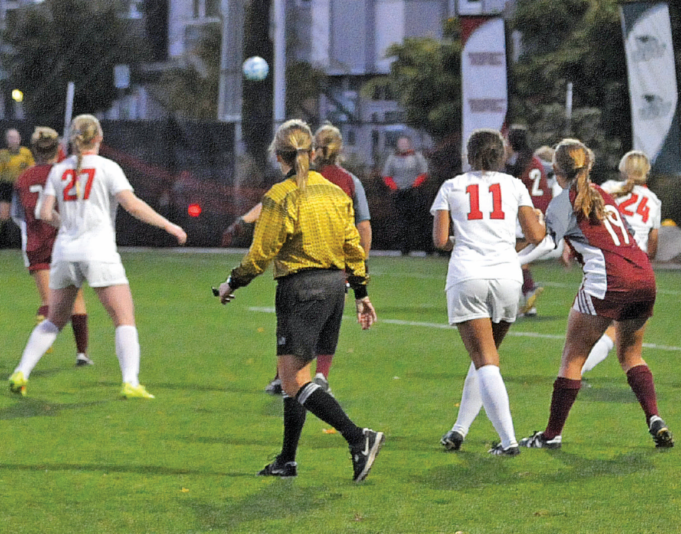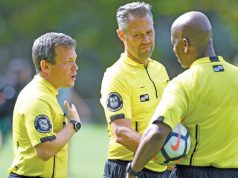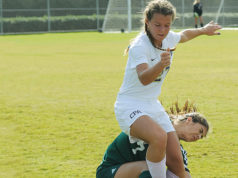Proper positioning is being where you have to be, to see what must be seen, to make the correct decision. That includes seeing the point.
During dynamic play, we are taught to look through play to our lead assistant referee (LAR) and to stay within 15 yards of play. Our movement should be fairly constant — feet moving, body turning, eyes focused on play and the surrounding area, mind constantly concentrating on getting the best possible view of “the point.”
The point is where opponents will come into contact, a player will contact the ball, the ball can be judged as still on the field, players commit misconduct, etc.
To view the point, it is crucial to read the game. Know where the ball is likely to go, who the star players are, who distributes the ball, who does not want the ball, etc.
Getting straightened out.
Being straightlined reduces decision making to guesswork. How many times have we had a good view of play, only to have someone step into our line of sight, obscuring the point? We must be alert, moving forward, backward, sideways, so that we can still see the point, anticipating straightline potential and avoiding it. Where there is a 50-50 ball between an oncoming attacker and oncoming goalkeeper, move diagonally two steps upfield to see the point. Do not move sideways, as play will continue moving farther away from you. Distance blurs precision and weakens credibility.
Getting too close to play narrows your field of vision and unduly curtails your ability to deal with off-the-ball fouls and misconduct. For example, where the LAR is focused solely on the second-to-last defender and the lead attacker, the LAR will not be able to judge if the follow-up goal was legal or resulted from gaining an advantage by being in an offside position. Widen your field of vision to include converging attackers. A good at-home exercise is to stand about six feet from a wall, facing parallel to it. Bounce a tennis ball against the ground and off of the wall, using the off hand. The ball will suddenly appear in your peripheral vision, much as a converging attacker running onto the rebound of a shot. That will break your habit of so narrowing focus that you miss what else is going on.
We don’t wear shinguards.
No referee wants to be struck by the ball or to impede the flow of play. In a men’s amateur open match, I found myself within a foot of opponents contesting a ball at their feet. I looked up and A5 had a two-handed hold on B7’s arm. I whistled and the offender, only half-jokingly, chided me, “You were too close to see that!” He was right!
A means of escape when too near is to “hide,” moving slightly behind a nearby defender. Attackers rarely pass directly to a defender, so “hiding” can keep you out of their way (Don’t completely hide so that you can’t see the point).
Set pieces near the goal.
What referees sometimes get wrong is straightlining themselves by standing too close to either end of the wall. Referees need a good view of each of the bricks, especially where there are also some “doors,” i.e., attackers within. Referees must be able to watch for holding, interlocked arms to deny space, tripping, etc. The wall is the point. You are a powerful deterrent to fouls and misconduct within the wall, if you are watching the point.
Goalkicks.
Be where you can best see where the ball is likely to land, based on weather, tactics and your prematch observation of goalkeepers practicing goalkicks. That is the point.
Be close enough to the point to use your personality to communicate with the players. Personality is a continuum, from a dirty look to almost whistling a foul. Personality prevents fouls and misconduct.
Be close enough to see their eyes. Was the player focusing on the ball or the opponent? In an MLS match, a free kick was awarded to the visitors in their defensive third, playing much like a goalkick into the other half. The home defender was alongside an attacker. The defender put a hand on the top of the attacker’s shoulder and, when the attacker had both feet off of the ground, gave a slight tug. The attacker could not get his or her feet underneath, fell heavily and was assisted off the pitch. A good referee lost the point (and wasn’t able to view the contact).
Corner kicks.
There is justifiable emphasis on varying of position to avoid “predictability,” i.e., being liable to gamesmanship, by remaining in the same position for corner kicks. An offensive tactic is the stationing of attackers who bracket the goalkeeper in order to impede. The referee must be able to not only see that “point,” but be able to effectively deal with the situation. Let everyone know that you are watching, so that the goalkeeper or a teammate does not take matters into his or her own hands. Let the attackers know that they must play for the ball. You only have to call the foul once.
Get it?
Whether during dynamic play or at set pieces, an important strategy is to be where you can see the point. Move your feet. Turn your body. Know where play is going and who will get the ball next. Avoid being straightlined by reading the game. Look through play to your LAR. Be on top of opponent-to-opponent contact or player-to-ball contact. After all, that’s the point.
What's Your Call? Leave a Comment:
Note: This article is archival in nature. Rules, interpretations, mechanics, philosophies and other information may or may not be correct for the current year.
This article is the copyright of ©Referee Enterprises, Inc., and may not be republished in whole or in part online, in print or in any capacity without expressed written permission from Referee. The article is made available for educational use by individuals.


















